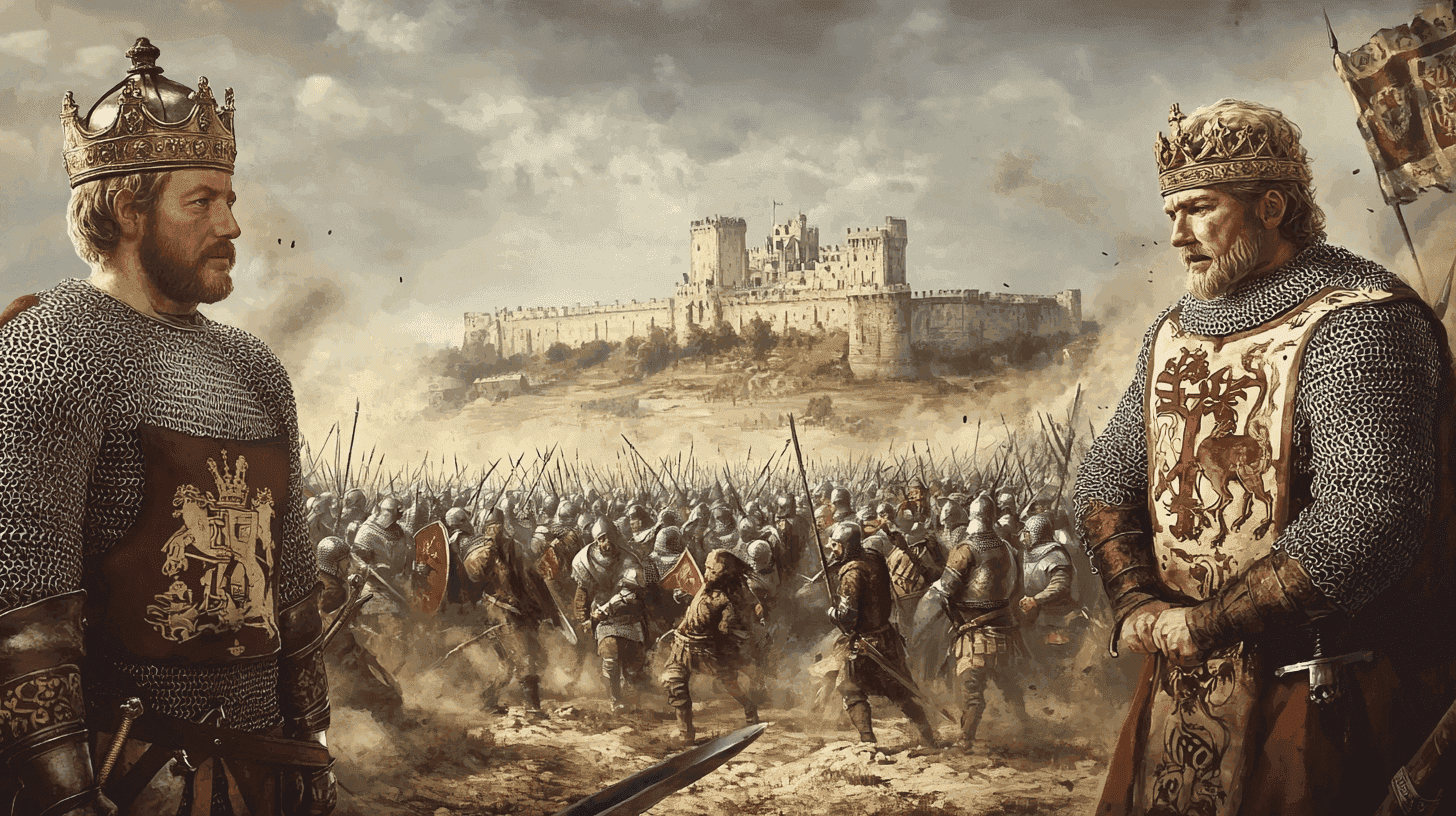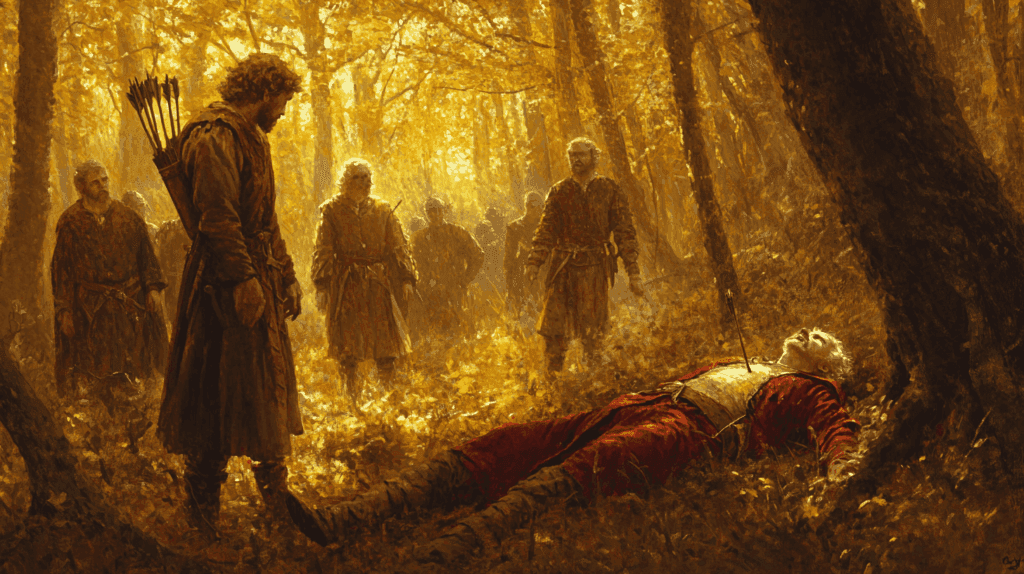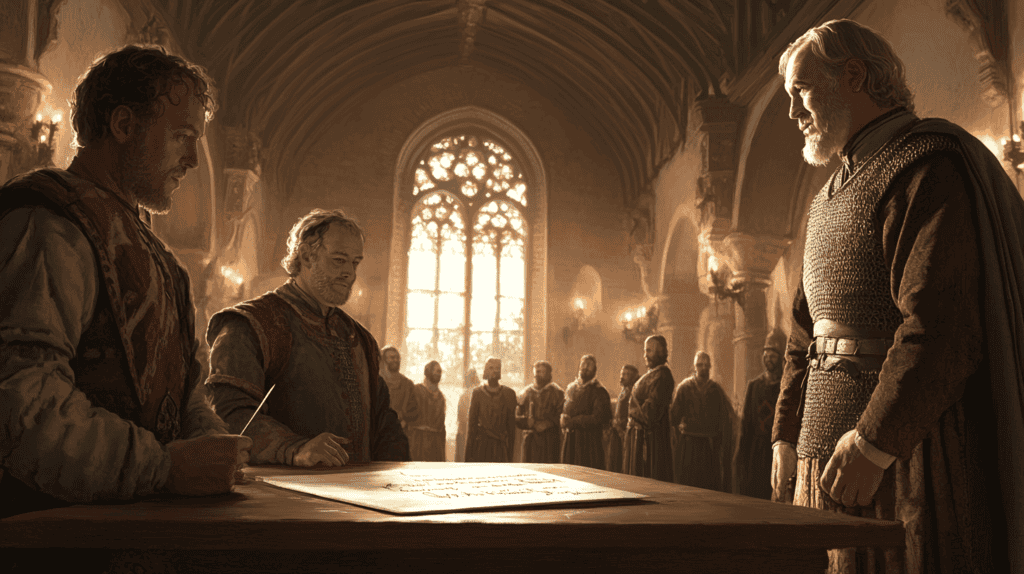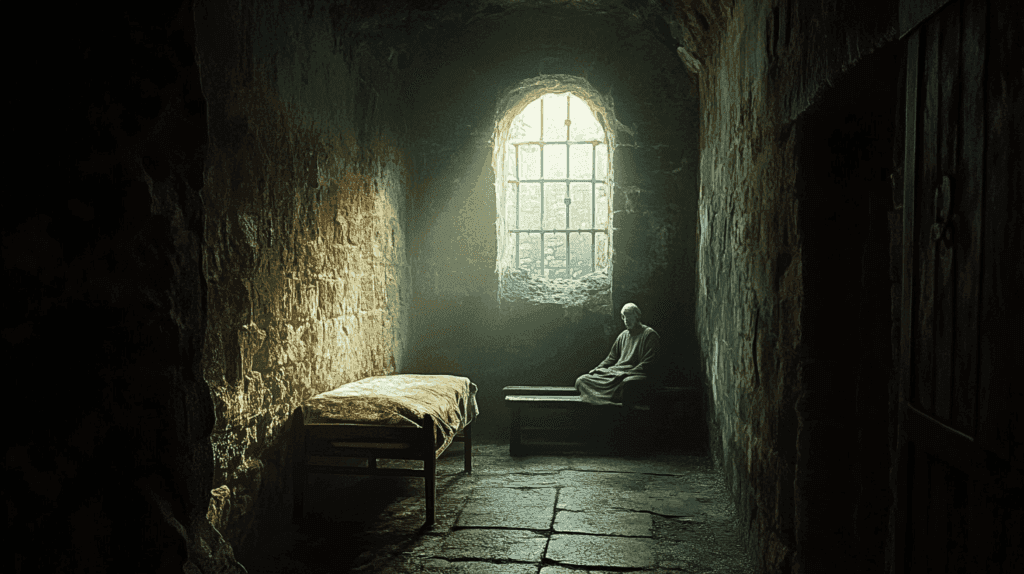
The Battle of Tinchebray, fought on September 28, 1106, reshaped the political landscape of both England and Normandy. This decisive conflict pitted two brothers against each other: King Henry I of England and Duke Robert Curthose of Normandy, both sons of William the Conqueror.
Background and Causes
When William the Conqueror died in 1087, he divided his lands according to Norman tradition: Normandy went to his eldest son Robert Curthose, despite being in armed rebellion against his father at the time of his death, while England was given to his second son, William Rufus who was in favor with the dying king. Henry, the youngest son, was initially given only £5,000 and expected to receive modest lands in the English counties of Buckinghamshire and Gloucestershire.
The reign of William Rufus
William Rufus’s reign began with immediate challenges. In 1088, just a year after his coronation, he faced a significant baronial rebellion led by his uncle, Odo of Bayeux. The rebellion aimed to place Robert Curthose on the English throne, uniting England and Normandy under a single ruler. However, the politically astute William quelled the uprising by appealing to the English people with promises of lower taxes and better governance.
William was a skilled military leader, extending Anglo-Norman rule in Wales and bringing Scotland firmly under his lordship. In 1091, he invaded Normandy, crushing his brother Robert’s forces and forcing him to cede a portion of his lands.
The end of William Rufus’s reign came suddenly and mysteriously on August 2, 1100. The king was hunting in the New Forest when he was struck by an arrow and killed. The official account states that Sir Walter Tirel, a nobleman in the hunting party, accidentally shot the king while aiming at a stag.

However, the circumstances surrounding William’s death have long been a subject of debate among historians with a strong suspicion of foul play. Immediately after the incident, Tirel fled to France and never returned to England, while William’s younger brother, Henry, was present at the hunt and quickly seized the opportunity to claim the English crown.
Within hours of William’s death, Henry rode to Winchester, the location of the royal treasury. This was a crucial first step, as control of the treasury was essential for asserting authority in medieval England. At Winchester, a brief dispute erupted among the gathered nobles over the succession, but Henry and his supporters managed to prevail.
With control of the treasury secured, Henry moved quickly to solidify his claim to the throne. He rode to London, covering the distance from the New Forest in record time. His haste was warranted, as his elder brother, Robert Curthose, the Duke of Normandy, had a stronger claim to the throne but was away on crusade. On August 5, 1100, just three days after William’s death, Henry was crowned King of England at Westminster Abbey.
Robert Curthose, Duke of Normandy
In 1096, Robert had joined the First Crusade, mortgaging his duchy to his brother William II to finance his participation. Robert’s role in the Crusade was significant: he fought at the Battle of Dorylaeum in 1097 and was present at the capture of Jerusalem in 1099. His courageous leadership contributed to the victory at the Battle of Ascalon in the same year. Robert’s participation in the Crusade made him one of the most famous warriors of his age, with a reputation that stretched from Scotland to Palestine.
Robert returned to Europe in 1100 as a chivalric hero. However, he found the political landscape had shifted dramatically. His younger brother, Henry I, had succeeded William II as King of England.
In the summer of 1101, Robert launched an invasion of England, landing at Portsmouth with a formidable force. Several powerful barons, including Robert of Belleme, Earl of Shrewsbury, and William of Mortain, Earl of Cornwall, rallied to his cause.
The stage seemed set for a decisive battle between the brothers, but fate had other plans. Through a combination of diplomacy and strategic maneuvering, Henry managed to avoid a direct confrontation. Instead, the brothers reached an agreement known as the Treaty of Alton. Under its terms, Robert renounced his claim to the English throne in exchange for an annual pension of 3,000 marks. Additionally, each brother was named as the other’s heir should they die without a legitimate son.

A Very Temporary Peace
The Treaty of Alton proved to be merely a temporary respite in the brothers’ rivalry. The years that followed saw increasing tensions as Henry consolidated his power in England and began to cast his gaze across the Channel to Normandy. Robert’s rule in the duchy was characterized by a degree of laxity that allowed powerful barons to act with near impunity, creating a state of near anarchy.
Henry, ever the shrewd politician, began to exploit this situation to his advantage. He cultivated alliances with Norman barons who were dissatisfied with Robert’s rule, gradually building a network of supporters within his brother’s territory. This strategy would prove crucial in the events that were to unfold.
In 1105, Henry decided that the time was ripe to make his move. He launched an invasion of Normandy, quickly capturing the important cities of Bayeux and Caen. This campaign demonstrated Henry’s military acumen and his ability to leverage the political situation to his advantage. However, he was forced to cut the campaign short due to political issues back in England related to the ongoing investiture controversy.
Despite this setback, Henry had made significant inroads into Normandy and had weakened Robert’s position considerably. The stage was now set for the final act of this fraternal drama, which would play out the following year at Tinchebray when Henry returned to Normandy to resume his campaign.
The Battle
Prelude
In the summer of 1106, Henry besieged Tinchebray Castle, a stronghold on the border of the county of Mortain in southwestern Normandy. The castle was held by William, Count of Mortain, one of the few remaining Norman barons loyal to Robert. This siege prompted Robert to march his forces to relieve the castle, setting the stage for the confrontation.

Tactics and Deployment
Henry’s army was split into two groups: the main forces led by Ranulf of Bayeux, Robert de Beaumont, and William de Warenne lined up facing Robert’s forces, while a smaller reserve force commanded by Elias I of Maine, was positioned out of sight on the flank.
In a surprising tactical decision, Henry ordered most of his knights to dismount, a move that was unusual for Norman battle tactics of the time. This decision would prove crucial, as it allowed the infantry to play a decisive role in the battle.
The Clash
The battle lasted only about an hour, but its impact would be felt for generations. William, Count of Évreux, led the charge against Robert’s front line with Norman men from Bayeux, Avranches, and the Cotentin. This internecine aspect to the battle made the fighting particularly intense, with both sides vying for supremacy.
The turning point came when Henry’s hidden reserve force, led by Count Elias of Maine, entered the fray. This unexpected reinforcement broke Robert’s lines, leading to a total collapse of his army’s morale and discipline, and the battle ended quickly in a decisive victory for Henry I. Most of Robert’s army was captured or killed. Among the notable prisoners were Robert Curthose himself, Edgar Atheling (uncle of Henry’s wife), and William, Count of Mortain.
While most prisoners were eventually released, Robert Curthose and William of Mortain spent the rest of their lives in captivity. Robert was initially held in Devizes Castle before being transferred to Cardiff Castle, where he remained until his death in 1134.

Historical Significance
Henry’s victory allowed him to reunite the two parts of his father’s realm under a single ruler, strengthening the Anglo-Norman kingdom. The ending of Robert Curthose’s rule in Normandy, and his claims to the English throne, solidified Henry’s position as one of the most powerful rulers in Western Europe.
However, despite Henry’s victory, the conflict was not entirely resolved. Robert’s son, William Clito, would continue to press claims to Normandy, leading to several rebellions throughout Henry’s reign.
Some early historians viewed the Battle of Tinchebray as a form of poetic justice, seeing it as revenge for the Norman conquest of England at the Battle of Hastings in 1066. In a twist of irony, Normandy was now conquered by the English, albeit under the rule of a Norman king. The battle shaped the course of English history for generations, solidifying the Anglo-Norman realm and setting the stage for England’s continued involvement in continental affairs.




